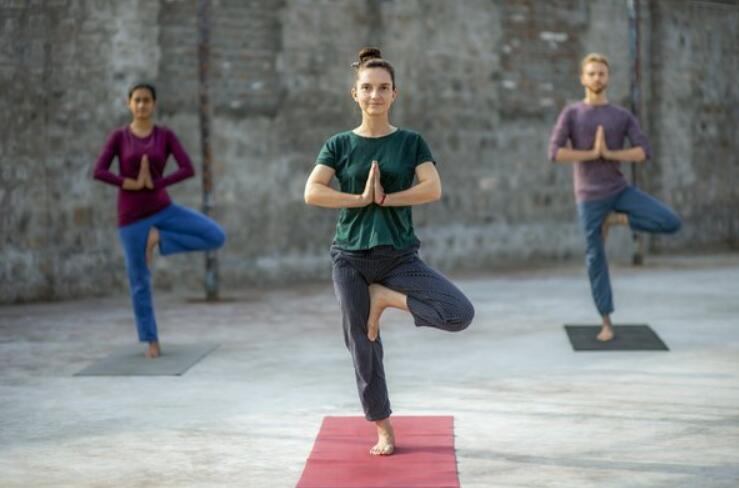Yoga is a powerful practice that offers numerous benefits for the mind, body, and soul. However, to experience the full potential of yoga, finding a balance in your practice is crucial. In this article, we explore key questions surrounding yoga practice and provide insights on the optimal frequency of sessions, the importance of incorporating rest days, the effectiveness of once-a-week practice, and the considerations of overdoing it, especially in the context of hot yoga.
How often should you do yoga?

Beginners or those with limited time: If you’re new to yoga or have a busy schedule, starting with two to three yoga sessions per week would be a good starting point. Each session can range from 30 minutes to an hour, depending on your availability and preference. It’s important to prioritize consistency and gradually increase the duration as you become more comfortable and develop your practice.
Intermediate practitioners: For those who have been practicing yoga for a while and are looking to deepen their practice, aiming for three to four sessions per week is recommended. Each session can range from 45 minutes to 90 minutes, allowing for a more comprehensive and immersive practice.
Advanced practitioners or dedicated yogis: If you have a strong commitment to your yoga practice and want to engage in a more intensive routine, you can consider practicing five to seven days a week. Sessions can range from 60 minutes to 120 minutes, with a mix of longer and shorter practices to provide variety and prevent burnout.
Do you need rest days from yoga?
Rest days play a crucial role in any fitness regimen, including yoga. They provide an opportunity for your body to recover and rejuvenate, preventing burnout, muscle fatigue, and injuries.
Rest days also help maintain the delicate balance between effort and ease in yoga practice. The frequency of rest days depends on the intensity and duration of your sessions, as well as your individual needs.
While beginners may benefit from more frequent rest days, advanced practitioners might find that one to two rest days per week are sufficient. On rest days, you can engage in gentle stretching, meditation, or other activities that nourish your body and mind.
Will practicing yoga once a week make a difference?
While consistency is key to reaping the benefits of yoga, even practicing once a week can make a noticeable difference. A weekly yoga session allows you to cultivate mindfulness, improve flexibility, relieve stress, and enhance overall well-being.
To maximize the impact of once-a-week practice, it’s important to focus on quality over quantity. Mindful, concentrated practice, emphasizing proper alignment and breath control, can amplify the benefits of each session.
Consider supplementing your weekly practice with shorter daily sessions or other cross-training activities to maintain a connection to yoga throughout the week.
Can I do hot yoga every day?
Hot yoga, performed in a heated room, offers a unique set of benefits, including increased flexibility, detoxification, and improved cardiovascular endurance. However, it’s essential to approach daily hot yoga practice with caution.
The intense heat can place additional stress on your body, and without proper precautions, it may lead to dehydration, overheating, or overexertion.
To safely incorporate hot yoga into your daily routine, prioritize hydration, listen to your body’s signals, and gradually increase the intensity of your practice. Additionally, consider diversifying your yoga routine with non-heated practices to avoid overdoing it and allow for balanced development.
Can you overdo it with yoga?
While yoga is a beneficial practice, it is possible to overdo it. Overexertion may lead to physical fatigue, mental exhaustion, and even recurring injuries. It’s crucial to listen to your body and practice mindfully, honoring your limits and boundaries. Remember that yoga is not solely about pushing yourself but also about embracing self-care and balance.
Incorporate restorative practices, such as gentle yoga or meditation, into your routine to counterbalance intense sessions. Moreover, diversify your workouts to avoid overemphasis on certain muscle groups and prevent burnout. By finding the right balance, you can establish a sustainable and transformative yoga practice.
Conclusion
Achieving balance in your yoga practice is a personal journey that requires self-awareness, adaptability, and dedication. By understanding the optimal frequency of practice, incorporating rest days, being mindful of hot yoga, and avoiding overexertion, you can create a well-rounded practice that nourishes both your body and mind.
Embrace the power of consistency, yet stay attuned to your individual needs and limitations. Through this balanced approach, yoga can truly become a lifelong companion, guiding you towards enhanced physical strength, mental clarity, and spiritual growth.
